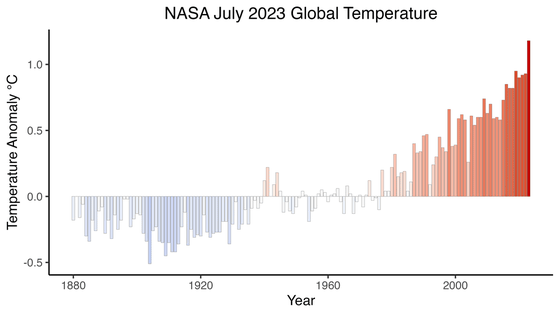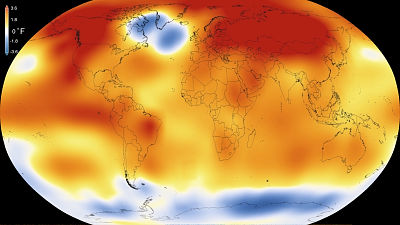NASA Recognizes July 2023 as 'Hottest Month Since 1880'

According to
NASA Clocks July 2023 as Hottest Month on Record Ever Since 1880 | NASA
https://www.nasa.gov/press-release/nasa-clocks-july-2023-as-hottest-month-on-record-ever-since-1880

July 2023 was the hottest month on record, according to our global temperature analysis. Overall, July was 0.43°F (0.24°C) warmer than any other July in @NASAEarth 's record, and it's likely due to human activity. Details: https://t.co/2DTIfL8S1Q pic.twitter.com/qs8YPnVx1y
— NASA (@NASA) August 14, 2023
July 2023 is 0.43 degrees Fahrenheit (0.24 degrees Celsius) hotter than the average temperature of other months that NASA has recorded so far, and the 'average temperature in July' for the period from 1951 to 1980 (normal value) It became clear that it was 2.1 degrees Celsius (1.18 degrees Celsius) hotter than This was made clear from data compiled by the Goddard Institute for Space and Astronautical Science, ' GISTEMP v4 ,' which summarizes estimated values of surface temperature changes on a global scale.
'GISTEMP v4' is data that summarizes long-term temperature changes over decades and centuries, and by fixing the reference period, it becomes possible to detect consistent anomalies over time. . Temperature 'normal' is defined over decades, usually in 30-year increments.
“NASA data confirms what billions of people around the world have literally felt,” said NASA Administrator Bill Nelson. Americans are now experiencing the effects of the climate crisis first-hand in every corner of the country, underscoring the urgency of President Biden's historic climate change plan. We must act now.It is the only option we have.'
The graph below summarizes the `` average temperature in July of each year '' since 1880 when temperature observation started. We can see that since 1980, the average temperature in July has risen sharply above normal.

Parts of South America, North Africa, North America and the Antarctic Peninsula were particularly hot, with temperatures 7.2 degrees Fahrenheit (4 degrees Celsius) hotter than average, according to NASA. This summer's heatwave has sent tens of millions of people on heat alerts and hundreds of others experiencing heat-related illness and death. In addition, the long-term trend of human-driven warming from greenhouse gas emissions that has become apparent over the past 40 years continues in July 2023. According to NASA data, the 'hottest July' has occurred five times since 1880, all in the past five years.
'Climate change is impacting people and ecosystems around the world, and continued warming will exacerbate many of these impacts,' said Catherine Calvin, chief scientist and senior climate adviser at NASA headquarters. It is expected.' ``Our agency monitors climate change and its effects, greenhouse gases and other effects, and is committed to providing information that helps people plan for the future.'' doing.
The climate data used by GISTEMP v4 consists of surface temperature data measured by meteorological stations installed in tens of thousands of locations around the world, and sea surface temperature data obtained by instruments installed on ships and buoys. .
“Not only was July 2023 the hottest July ever, it was also the hottest month on record going back to 1880,” said Gavin Schmidt, director of the Goddard Space Institute. It is scientifically clear that this is not normal.The tremendous warming that is happening around the world is largely caused by man-made emissions of greenhouse gases.The increase in average temperatures is only in the United States. It contributes to the dangerous and extreme heat that people around the world are experiencing.'

The record heat in July 2023 was partly due to the high sea surface temperature, and it seems that the sea temperature in the eastern part of the tropical Pacific was particularly high. According to NASA analysis, this is the effect of El Niño, which began to develop in May 2023. Events such as El Niño and La Niña, which warm and cool the tropical Pacific Ocean, can make small contributions to annual temperatures. However, when El Niño begins to develop in the Northern Hemisphere summer, these effects are usually not felt. According to NASA, the impact of El Niño is expected to be greatest around February to April 2024.
Related Posts:
in Science, Posted by logu_ii







